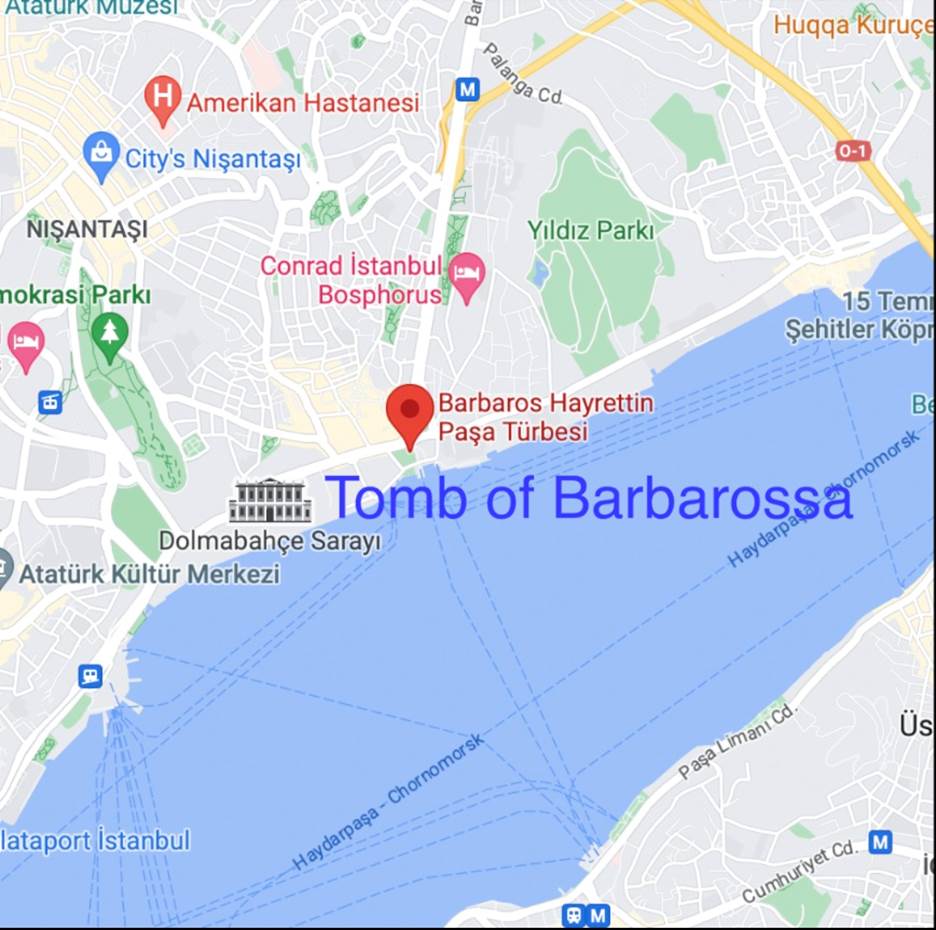
The author in front of the Barbarossa Memorial
The Adventures and Exploits of Ottoman Admiral Hayreddin Barbarossa
By Dr Khalid Siddiqui
Ohio

Barbarossa’s real name was Khizr. He was born in Greece in 1473 to an Ottoman Turk father and a Greek Orthodox Christian mother. He and his three brothers worked as privateers in the Mediterranean Sea.
Privateers were sort of contracted pirates. They were issued a license to attack and capture a ship of a nation at war with the issuer. The booty was then shared. It was a common practice from mid-16 th to mid-19 th centuries. The brothers developed a great reputation. They continued to capture coastal towns and small islands belonging to Spain and Italy.
However, after the death of Khizr’s elder brother in 1518, his position weakened. He contacted Ottoman Sultan Selim I in 1519 and offered his allegiance and services. He was given the honorary name of Hayreddin (pronounced as Khairuddin). He also inherited his brother’s nickname Barbarossa (“Redbeard” in Italian). With Turkish reinforcements he resumed his raids in the Mediterranean Sea.
He also continued the policy of bringing mudejars from Spain to North Africa, thereby assuring himself of a sizable following of the grateful and loyal Muslims who harbored an intense hatred for Spain. Mudéjar was originally the term used for Muslims of Spain who remained in Iberia after the Christian Reconquista but initially were not forcibly converted to Christianity, or exiled.
In 1520, Suleiman the Magnificent, succeeded Selim I as the new Ottoman sultan. He appointed Barbarossa the Grand Admiral of the Ottoman Navy and Beylerbey (“Chief Governor”) of North Africa. In 1533, King Francis I of France and Ottoman Suleiman entered into a naval alliance against the Spanish and Italians. Many successful operations were carried out jointly by Barbarossa and the French Navy to liberate the French territories occupied by Spain and/or Italy.
The clashes between Barbarossa and the Spanish/Italian navies continued. In February 1538, Barbarossa defeated the Holy League assembled by Pope Paul III at the Battle of Preveza. This victory secured Ottoman domination over the Mediterranean Sea for the next 33 years, until the Battle of Lepanto in 1571.
Barbarossa retired in 1545. He dictated his memoirs to Muradi Sinan Reis. It consists of five hand-written volumes known as Gazavat-ı Hayreddin Paşa (Conquests of Hayreddin Pasha). Today, they are exhibited at the Topkapi Palace and Istanbul University Library.
Barbarossa died in 1546. He is buried in a mausoleum in Besiktas, Istanbul, which was built in 1541 by the famous architect Mimar Sinan, at the site where his fleet used to assemble. His memorial was built in 1944, next to his turbesi (mausoleum). No fleet passes this point without firing a salute at his mausoleum.
Barbaros Boulevard is named after him. Edward Keble Chatterton, the famous British naval military historian, wrote that "his death was received by Christian Europe with a sigh of the greatest relief". Although the Turkish Navy had several great seamen before or after him, few other Ottoman admirals ever achieved the overwhelming naval power of Hayreddin Barbarossa.

Several warships of the Turkish Navy and passenger ships have been named after him. Barbarossa has been the subject of many Turkish and foreign films, and TV series. He is also one of the main characters in Mika Walari’s book, The Wanderer (1949).
Note: At the Battle of Lepanto which took place on 7 October 1571, a fleet of the Holy League inflicted a major defeat on the fleet of the Ottoman Empire. However, even after that defeat, the Ottomans quickly rebuilt their fleet, gained Cyprus and other territories in Morea and Dalmatia from the Republic of Venice between 1571 and 1573, and reconquered Tunisia from Spain in 1574.

